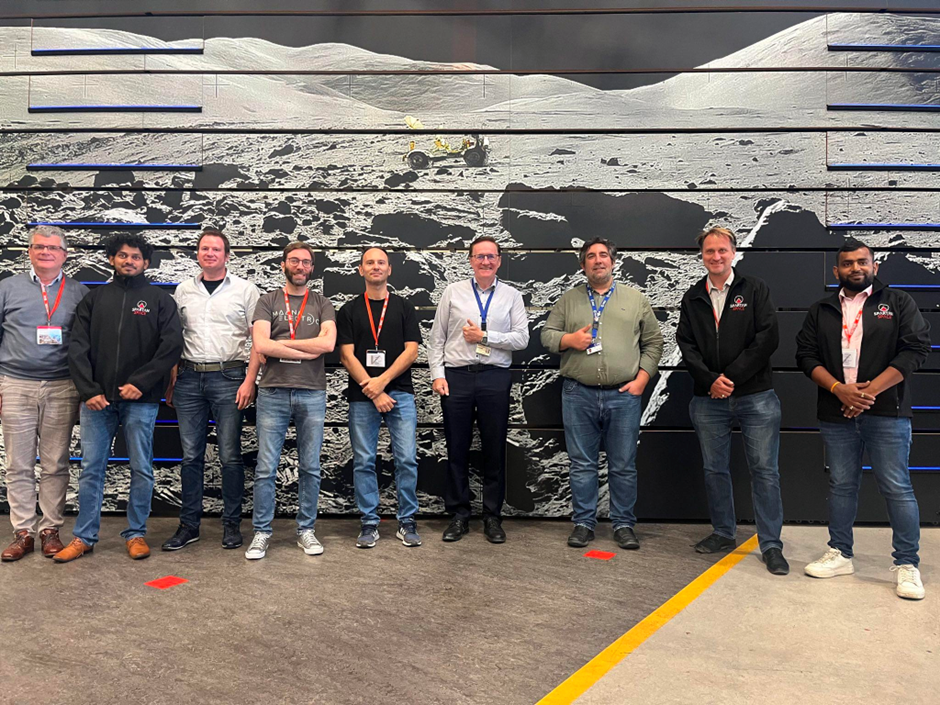Press Release: Future lunar surface simulator in the form of a Dusty Thermal Vacuum chamber to be developed in Luxembourg

Management of the winning consortium and ESA representatives gathered during the Kick-Off Meeting at ESTEC.
Luxembourg – 04 September 2022
On the 13th of June 2023 at ESTEC, Netherlands. the European Space Agency (ESA) conducted the Kick-Off Meeting with Spartan Space, Haux Life Support, Maana Electric, and the European Space Resources Innovation Centre (ESRIC) – part of the Luxembourg Institute of Science and Technology (LIST) – to manufacture a novel Scenario 3 scale Dirty Thermal Vacuum chamber (capable of testing subsystem components at 10-6 mbar in the presence of regolith simulant). The chamber will be commissioned at the ESRIC/LIST premises in Luxembourg.
The European Space Agency, in collaboration with international partners, is focused on future lunar missions involving both human and robotic activity. These missions aim to establish a sustainable presence in lunar orbit and on the surface. Recognizing the Moon as a crucial testing ground for future solar system exploration, the emphasis is on developing a more complex infrastructure, particularly around the lunar South Pole. Unlike the Apollo missions that targeted various locations, programs like ARTEMIS prioritize the South Pole, which offers the advantage of reusing equipment for multiple missions. Europe can contribute logistic elements, such as the ARGONAUT and various robotic missions that can facilitate the supply chain between a lander and a crew, and integrated Lunar Charging Stations with scientific instruments or a Secondary Habitat to extend surface operations. It is important to note that the involvement in lunar missions is not limited to space agencies; commercial actors are now playing significant roles in lunar exploration, including in Europe.
The presence of lunar dust poses significant challenges to lunar missions, affecting the integrity of equipment and instruments. Astronauts have reported various issues such as failing seals, impaired vision, and damage to solar panels due to dust accumulation. These problems can lead to malfunctions or mission failure. Furthermore, lunar dust hampers the accurate collection of data by interfering with scientific instruments, resulting in incomplete or inaccurate data. To address these challenges, scientists and engineers have developed innovative solutions such as dust-resistant coatings and protective covers. As we plan for future lunar missions, it is crucial to continue advancing technologies and strategies to mitigate the impact of lunar dust and ensure mission success.
“The Dusty Vacuum Thermal Chamber (DTVC) that will be implemented in Luxembourg will be a gateway to the lunar surface: critical equipment can be tested in high vacuum in the presence of lunar dust (regolith). With its dimensions and vacuum capacities, it will be unique in Europe and allow testing equipment before embarking on a lunar mission” states Peter WEISS, CEO of SPARTAN SPACE. “We are particularly happy to have assembled a very strong consortium of experts in this field with HAUX, MAANA, and LIST/ESRIC”.
In the coming decades of lunar surface missions, the implementation of a Scenario 3 Dirty vacuum chamber (DTVC) will be of utmost importance for qualifying and accepting components crucial to the success of lunar missions. The DTVC serves to prevent the occurrence of late discovery problems and mitigate risks during proto-flight and acceptance testing. By subjecting subsystems to simulated dirty vacuum conditions, the mission system owner can effectively reduce the mission’s early failure rate to an acceptable level. This risk mitigation objective is particularly significant in addressing latent defects that may manifest in vacuum, temperature, and environmental stress conditions of space. Testing in the DTVC enables the detection of defects that may have been overlooked or unanticipated in the design, materials, parts, processes, and workmanship, thereby ensuring the thorough qualification of mission components.
Dr Melchiorre CONTI, Space Resources Engineer at the European Space Agency further explains, “the Space Resources field is up and coming, with a vibrant collaborative community who looks to develop new and innovative technologies to enable the Lunar Economy in the future. This facility, along with others procured by ESA and located at the ESRIC, is part of series of research infrastructures to service the European industries, making ESRIC a unique place for research and development of Space Resources-related research”.
About SPARTAN SPACE: Spartan Space is a NewSpace company developing smart habitats for space and underwater. The company is headquartered in France and was created by a group of senior space and underwater engineers, astronauts and architects. Spartan Space aims to promote international cooperation that will enable humanity to live and work on the Moon, Mars and underwater like on Earth. Press Contact: Agatha Medioni, a.medioni@spartan-space.com
About HAUX LIFE SUPPORT: HAUX LIFE SUPPORT GmbH, founded in 1980 and owned by the HAUX family, is a prominent manufacturer of hyperbaric chamber systems with over 40 years of experience. Committed to quality and compliance, HAUX LIFE SUPPORT manufactures innovative solutions for hyperbaric medicine, diving, and extreme environment applications. HAUX has built over 1500 pressure chambers. Press Contact: Torsten Haux, thaux@hauxlifesupport.de
About MAANA ELECTRIC: MAANA ELECTRIC SA is a deep tech company specializing in the development of In Situ Resources Utilization systems. With a focus on energy generating systems, particularly photovoltaics, Maana Electric pioneers the development of disruptive technologies for sustainable energy production, both on Earth and in space. Press Contact: Luca Celiento, communication@maanaelectric.com
About ESA: European Space Agency (ESA) is a unique place where technologies, businesses and people meet to drive the future of space resources utilization in support of space exploration and the creation of an in-space economy. Press Contact: Rosita Suenson, rosita.suenson@esa.int
